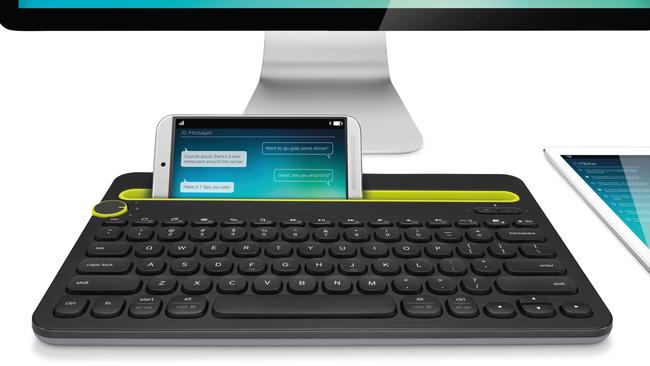Logitech targets mobile devices, gaming for growth
COMPUTER peripheral maker Logitech is focusing on accessories for mobile devices and gaming in an effort to reignite double-digit growth.

COMPUTER peripheral maker Logitech is cribbing from Microsoft and Nokia’s playbook by pivoting from the business that made it famous to focus on products that piggyback on mobile computing popularised by Apple and Samsung.
The company, whose PC mouse devices could be found on desks the world over in the first wave of the IT revolution, is now focusing on accessories for mobile devices and gaming in an effort to reignite double-digit growth, according to chief executive Bracken Darrell.
Logitech will also soon release a low-cost video device for collaboration between individuals or small groups.
The company also has a string of research projects that are working on “logical but surprising” new areas of digital technology which tap into key trends including mobile.
Mr Darrell said Logitech would stay in the traditional mouse and keyboard business, but place less emphasis on it.
A key part of Mr Darrell’s strategy is to place more emphasis on what he calls the company’s growth category — PC gaming, tablet accessories and mobile speakers.
In the six months to September 30, Logitech’s sales in these sectors rose 21.5 per cent. In contrast, sales for the traditional parts of Logitech’s business, such as mouse devices, desktop keyboards and remote controls, fell by 1 per cent.
Nevertheless, the company will remain involved in the more traditional part of the business, which still makes up 66 per cent of its revenues and where it aims to maximise profit.
The change of direction echoes Microsoft, which switched to cloud-based business services from software, and former phone makers Nokia and Ericsson which have shed their handset business to concentrate on mobile networks.
Mr Darrell said Logitech wanted to post 5-7 per cent growth over the next three years, before accelerating to 10 per cent or higher sometime later.
The company, based in Newark, California and Lausanne, Switzerland, posted sales growth of 1.1 per cent and swung to a profit in the year ended March 31, 2014.
“We want to have double-digit growth and get back to where we were five or six years ago,” Mr Darrell said. “We want to have 10 per cent top-line growth and 10 per cent increase in operating income,” he added, without giving a specific target date.
Logitech’s ambitious targets come after a three-year turnaround prompted by the company’s failure to respond to the rise of Apple’s iPad and other mobile devices that displaced its core market of peripherals for desktop computers.
The company’s performance deteriorated so sharply, it was forced to post four profit warnings in 2011 and 2012, prompting a sell-off in the company’s shares that pushed its shares down about 55 per cent.
Under Mr Darrell, who joined in January 2013 after four years with home appliance manufacturer Whirlpool and more than a decade at Procter & Gamble, Logitech has cut costs by shedding 13 per cent of its staff, introduced mobile products and shortened the research-and-delivery time for new products.
Mr Darrell, who unveiled a new remote speaker that connects to mobile phones via Bluetooth earlier this week, said Logitech would bring out 20-25 new products this year.
The new products will mainly focus on peripherals for tablets, mobile speakers and PC gaming accessories.
In the past six months, Logitech has launched a range of products aimed at mobile markets and gaming, including what it says is the world’s fastest gaming mouse, and a gaming keyboard which it said is 25 per cent faster than a normal keyboard — a quality prized by players of online action games.
Helped by its increased emphasis on growth categories, in the six months ended September 30, 2014, Logitech’s profit nearly quadrupled to $US56 million ($68m).
The company’s shares trailed the Swiss Performance Index’s 11.3 per cent rise in 2014, but still gained 9.6 per cent.
“This is a very sustainable turnaround,” Mr Darrell said. “We have to prove we can turn this back into a growth company.”
Andreas Mueller, an analyst at Zuercher Kantonalbank, said: “It is possible to get sales growth of more than 10 per cent in one or two years — they have done that in the past — and you can if you get a blockbuster product.
“But can you do that every year? That is doubtful.”


